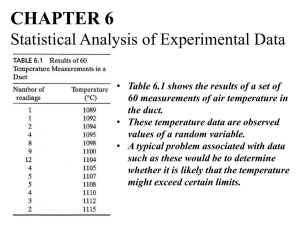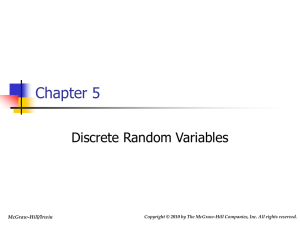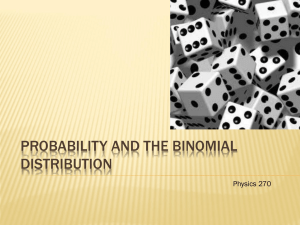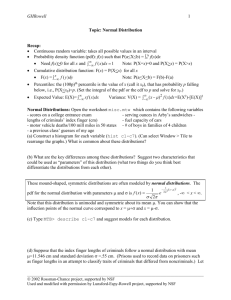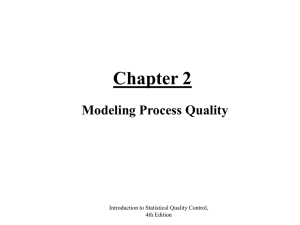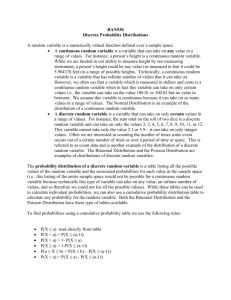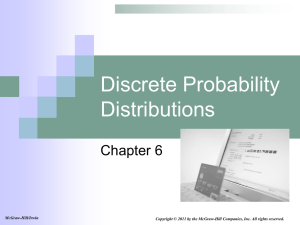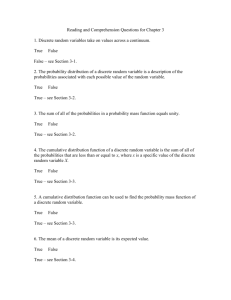normal distributions
advertisement
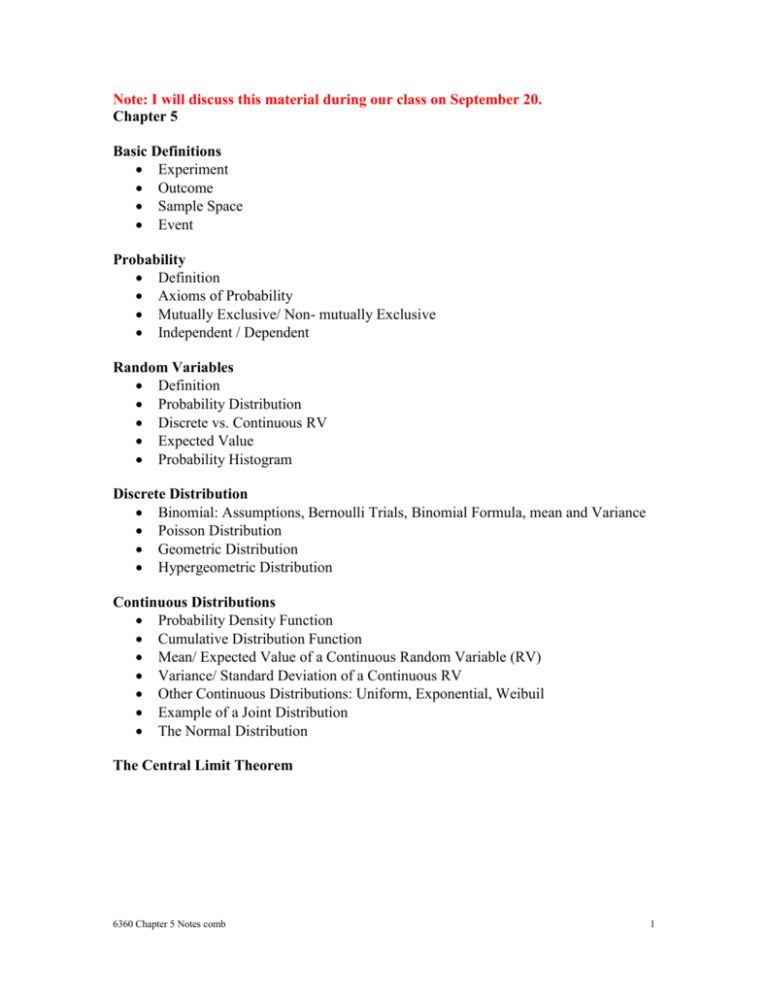
Note: I will discuss this material during our class on September 20. Chapter 5 Basic Definitions Experiment Outcome Sample Space Event Probability Definition Axioms of Probability Mutually Exclusive/ Non- mutually Exclusive Independent / Dependent Random Variables Definition Probability Distribution Discrete vs. Continuous RV Expected Value Probability Histogram Discrete Distribution Binomial: Assumptions, Bernoulli Trials, Binomial Formula, mean and Variance Poisson Distribution Geometric Distribution Hypergeometric Distribution Continuous Distributions Probability Density Function Cumulative Distribution Function Mean/ Expected Value of a Continuous Random Variable (RV) Variance/ Standard Deviation of a Continuous RV Other Continuous Distributions: Uniform, Exponential, Weibuil Example of a Joint Distribution The Normal Distribution The Central Limit Theorem 6360 Chapter 5 Notes comb 1 INTRODUCTION TO PROBABILITY Information in the Appendix. See if you can do any of these problems – we will discuss in our next class. 1. An experiment consists of drawing one car from a deck of 52 cards. What is the probability of a) a red card b) an ace c) a king d) a king or an ace e) a red card or a king 2. An experiment consists or drawing two cards with replacement. What is the probability of: a) a king on the first draw and a jack on the second b) a three on the first and a nine on the second? 3. An experiment consists or drawing two cards without replacement. What is the probability of: a) a king on the first draw and a jack on the second b) a king on both draws? 4. A bin contains 5 aluminum, 2 steel and 3 brass parts. Three parts are selected. Find the probability that they are drawn in the order brass, aluminum, steel. What is the probability that 2 are aluminum and 1 is brass? 5. The probability that an integrated circuit chip will have a defective etching is 0.12; the probability that it will have a crack defect is 0.29, and the probability that it has both defects is 0.07. a) What is the probability that a newly manufactured chip will have either an etching or a crack defect? b) What is the probability that a new chip will have neither defect? 6360 Chapter 5 Notes comb 2 PROBABILITY DISTRIBUTIONS Random Variable - Maps a real number to the outcome of an experiment Two Types of Random Variables 1. Discrete the random variable assumes discrete (countable) values 2. Continuous the random variable can assume values represented by a continuous interval of numbers Examples of Discrete Random Variable the number of automobile accidents in Houston. the number of building permits issued by the city during the last year the number of power failures per month the number of defective parts produced in a manufacturing operation Examples of Continuous Random Variable force required to break a certain tensile specimen voltage distance Probability Distribution for a Random Variable Assigns probabilities to the possible outcomes as measures of the likelihood that the various numerical values will occur Probability Function for a Discrete Random Variable For a discrete random variable X with possible outcomes of x1, x2, …., the probability function is a nonnegative function f(x) such that f(x) = P[X = x]. Note that the probability function of a discrete random variable is often expressed using a table. Properties: f(x) assumes values between 0 and 1 (inclusive) the f(x) values sum to 1 Cumulative Probability Function Assume X is a random variable. The function F(x) = P[X < x]. Note for a discrete random variable, F(x) = f(z) over z < x Mean or Expected Value of a Discrete RV E(X) = x * f(x) E(X) = X1*P(X1) + …. + Xn*P(Xn) Variance/Standard Deviation of a Discrete RV Var (X) = (x - EX)2 *f(x) = x2 *f(x) - EX2 6360 Chapter 5 Notes comb 3 Example of a Discrete Random Variable Let X = the number of imperfections in a roll of sheet metal. Suppose X has the following probability distribution. Probability Distribution of the Number of Imperfections x 0 1 2 3 4 f(x) 0.40 0.30 0.15 0.10 0.05 1.00 Note that the sum of the probabilities is 1. f(x) = 1 The random variable X assumes the number of imperfection found, i.e. there can be 0,1,2,3, or 4 imperfections on the roll. We formed a probability distribution by assigning probabilities to each of these outcomes. For example f(2) = P[X = 2] = 0.15 Cumulative Probability Distribution of Number of Imperfections x 0 1 2 3 4 f(x) = P[X = x] 0.40 0.30 0.15 0.10 0.05 F(x) = P(X x) 0.40 0.70 0.85 0.95 1.00 Note: F(3) = P[X < 3] = P[X < 2] = f(0) + f(1) + f(2) = 0.4 + 0.3 + 0.15 = 0.85 The expected value of a random variable is: E(X) = x f(x) = 0*.4 + 1*.3 + 2*.15 + 3*.1 + 4*.05 = 0 + 0.3 + 0.3 + 0.3 + 0.2 = 1.1 On the average we expect the number of imperfections to be 1.1. The variance of the random variable is: Var (X) = (x - EX)2 * f(x) Var (X) = x2 * f(x) - EX2 6360 Chapter 5 Notes comb 4 Example: Probability Histogram X = # of equipment failures in a one month period In the following example, the number of equipment failures can take on a value from 0 to 9. The probability distribution on the left lists each possibility with the associated probability that it will occur. The cumulative function is also shown. Equipment Failures E Q U IP M E N T F A IL U R E S IN O N E -M O N T H 0.3 6360 Chapter 5 Notes comb 0.2 0.15 0.1 0.05 9 8 7 6 5 0 4 2 6 6 6 9 4 3 2 1 1 1 3 .1 .2 .2 .1 .0 .0 .0 .0 .0 .0 0.25 2 0 0 0 0 0 0 0 0 0 0 F (X ) 0 .1 2 0 .3 8 0 .6 4 0 .8 0 .8 9 0 .9 3 0 .9 6 0 .9 8 0 .9 9 1 1 f(x ) 0 X 0 1 2 3 4 5 6 7 8 9 5 SOME DISCRETE PROBABILITY DISTRIBUTIONS Binomial Distribution The Binomial Distribution assumes the following An experiment is performed a finite number of times. Each outcome of the experiment can result in ‘success’ or ‘failure.’ There is a constant probability of success (and we will label it p) and a probability of failure (q = 1 - p). The trials of the experiment are independent, X is the number of successes in n trial of the experiment Examples number of defective parts number of projects that meet specifications number of employees that passed the training number of nonconforming transducers number of containers that are over filled Probability Function for the Binomial The binomial distribution has the following probability function X = the number of successes in n independent Bernoulli trials of an experiment f(x) = nCxpx * (1-p)n - x for x = 0,1,2….n f(x) = 0 otherwise Example of the Binomial A manufacturer claims that only 10% of his machines require repair within one year. Find the probability of 5 repairs from 20 machines. Use the Binomial formula to determine the probability of 5 repairs (i.e. successes) in 20 trials of the experiment. n = 20 x= 5 20C5 = 20!/5!* (20 – 5)! = 15,504 px = (0.1)5 = 0.00001 p = 0.10 q = 1 – 0.10 = 0.90 (1- p)n - x = (0.9)15 = 0.20589 P(X = 5) = 15504*0.00001*0.20589= 0.0319 6360 Chapter 5 Notes comb 6 Poisson Distribution The Poisson distribution counts the number of relatively rare events over a specified interval of space or time, Examples of the Poisson the number of flaws in a length of wire the number of particles of contamination that occur on a storage disk the number of messages arriving for routing through a switching center in a communications network the number of imperfections in a bolt of cloth the number of arrivals at a retail outlet Probability Function for the Poisson X = # of success in an interval of time, space, distance f(x) = e-x/x! for x = 0,1,2,…... f(x) = 0 otherwise Example of Poisson Tin plates that are produced by a continuous electrolytic process are inspected. The number of imperfections spotted per minute is 0.2. Find the probability of 1 imperfection in 3 minutes. e = 2.718… x=1 = 0.2 * 3 = 0.6 (If there are 0.2 imperfections in 1 minute, we have 0.6 imperfections in 3 minutes.) f(1) = (e-1)/1! = 0.329287 Geometric Distribution This distribution is similar to the Binomial, but it counts the number of trials to the first success. Probability Function for the Geometric X = # of trials until the first success f(x) = px(1-p)n-x for x = 0,1,2….n f(x) = 0 otherwise Example of the Geometric Distribution The probability that a measuring device will show excessive drift is 0.05. A series of devices is tested. What is the probability that the 6th device will show excessive drift? Find the probability of the 1st drift on the 6th trail. P(X = 6) = (0.05)*(0.95)5 = 0.039 6360 Chapter 5 Notes comb 7 Discrete Probability Distributions 1. Human error is the reason for 75% of all accidents in a plant. Find the probability that human error will be reported as the reason for two of the next four accidents. [27/128] 2. During one stage in the manufacture of integrated circuit chips, a coating must be applied. If 70% of the chips receive a thick enough coating, find the probabilities that among 15 chips: 2.1 at least 12 will have a thick enough coating [0.2969] 2.2 at most 6 will have a thick enough coating [0.0152] 2.3 exactly 10 will have a thick enough coating [0.2061] 3. The probability that the noise level of a wide band amplifier will exceed 2 dB is 0.05. for a group of 12 amplifiers, find: 3.1 one will exceed 2 dB 3.2 at most two will exceed 2 dB 3.3 two or more will exceed 2 dB 1. Given that the switch board of a consultants office receives on the average 0.6 calls per minute, find the probability that: 4.1 in a given minute, there will be at least one call 4.2 in a 4-minute interval, there will be at least three calls 2. At a check out counter, customers arrive at an average rate of 1.5 per minute. Find the probability that: 5.1 at most four will arrive in any given minute [0.981] 5.2 at least three will arrive during an interval of 2 minutes [0.577] 5.3 at most 15 will arrive during an interval of 6 minutes. [0.978] 6360 Chapter 5 Notes comb 8 Binomial and Poisson / Minitab Binomial Use Calc/Probability Distributions/Binomial MTB > MTB > MTB > SUBC> # Binomial #P = 0.05 and N = 16 CDF; Binomial 16 .05. Cumulative Distribution Function Binomial with n = 16 and p = 0.0500000 x 0 1 2 3 4 5 6 P( X <= x ) 0.4401 0.8108 0.9571 0.9930 0.9991 0.9999 1.0000 MTB > # Inverse Binomial MTB > MTB > INVCDF .1247; SUBC> Binomial 16 .05. Inverse Cumulative Distribution Function Binomial with n = 16 and p = 0.0500000 x 0 P( X <= x ) 0.0000 x 0 P( X <= x ) 0.4401 Poisson MTB > # Poisson with mean of 5 MTB > MTB > CDF; SUBC> Poisson 5. Cumulative Distribution Function Poisson with mu = 5.00000 x 0 1 2 3 4 5 6 7 8 9 10 11 12 13 14 15 16 P( X <= x ) 0.0067 0.0404 0.1247 0.2650 0.4405 0.6160 0.7622 0.8666 0.9319 0.9682 0.9863 0.9945 0.9980 0.9993 0.9998 0.9999 1.0000 6360 Chapter 5 Notes comb 9 CONTINUOUS RANDOM VARIABLES A continuous random variable can assume values represented by a continuous interval of numbers Examples current in a copper wire (variation from current source, temperature change…) diameter of a bolt (variation from calibration, tool wear, raw materials…) time to complete a machining operation length of time to play a set of badminton heights, weights, lengths, etc, Note the probability of selecting exact values cannot be measured; instead we are concerned with the probability of an interval of values, and tabular forms are no longer possible. Instead we use a function, referred to as the probability density function. Probability Density Function The function f(x) is a probability density function for the continuous random variable X, defined over the real numbers R if: f(x) > 0 for all x that are elements of R f(x)dx =1 b P(a < x < b) > f(x)dx a Note that consequence of X being a continuous random variable is that P(X =x) = 0 and when evaluating the probability of an interval, it is not necessary to consider the equality sign i.e. P(a < X < b) = P(a < X < b). Example The lead concentration in gasoline ranges from 0.2 to 0.6 grams per liter. Define the random variable X. X: grams of lead per liters The density of the random variable is given by f(x) = kx - 1 for 0.2 < x < 0.6 f(x) = 0 otherwise a) Find the value of k. 6360 Chapter 5 Notes comb 10 b) What is the probability that a liter of gas will have between .3 and .5 grams of lead? [Ref. Milton and Arnold] Solution According to the definition (kx-1)dx =1 0dx + (kx-1)dx + 0dx =1 Cumulative Distribution Function An alternate way of describe a continuous random variable is the cumulative distribution function (cdf). Assume X is a random variable. The function F(x) = P[X < x] x f(x) dx for x Example B For the distribution function of Example a, find the cumulative density function. Mean or Expected Value of a Continuous RV E(X) = x f(x)dx Variance/Standard Deviation of a Continuous RV Var (X) = (x - E(X))2 f(x)dx 6360 Chapter 5 Notes comb 11 NORMAL DISTRIBUTIONS • • • Family of distributions, all with the same general shape. Symmetric about the mean The y-coordinate (height) specified in terms of the mean and the standard deviation of the distribution Normal Probability Density For all x f ( x) 1 ( x )2 / 2 2 e 2 Standard Normal Distribution The normal distribution with =0 and =1 is called the standard normal. For all x: f (t ) 1 2 e t / 2 2 Transformations Normal distributions can be transformed to the standard normal. We use what is called the z-score, which is a value that gives the number of standard deviations that X is from the mean. Standard Normal Table Use the table in the text to verify the following. 1. P(z < -2) = F(2) = 0.0228 2. F(2) = 0.9773 3. F(1.42) = 0.9222 4. F(-0.95) = 0.1711 6360 Chapter 5 Notes comb 12 Example of the Normal The amount of instant coffee that is put into a 6 oz jar has a normal distribution with a standard deviation of 0.03. oz. What proportion of the jar contain: a) Less than 6.06 oz? b) More than 6.09 oz? c) Less than 6 oz? Normal Example - part a) Assume = 6 and = 0.03. The problem requires us to find P(X < 6.06) Convert x = 6.06 to a z-score z = (6.06 - 6)/.03 = 2 and find: P(z < 2) = .9773 So 97.73% of the jars have less than 6.06 oz. Normal Example - part b) Again = 6 and = 0.03. The problem requires us to find: P(X > 6.09) Convert x = 6.09 to a z-score z = (6.09 - 6)/.03 = 3 and find P(z > 3) = 1- P(x < 3) = 1- .9987= 0.0013 So 0.13% of the jars have more than 6.09oz. 6360 Chapter 5 Notes comb 13 Normal Distribution/ MTB MTB > # Use Calc\Probability Distributions MTB > # Normal Distribution MTB > CDF -1.77; SUBC> Normal 0.0 1.0. Cumulative Distribution Function Normal with mean = 0 and standard deviation = 1.00000 x -1.7700 P( X <= x ) 0.0384 MTB > PDF -1.77; SUBC> Normal 0.0 1.0. Probability Density Function Normal with mean = 0 and standard deviation = 1.00000 x -1.7700 f( x ) 0.0833 MTB > InvCDF .0833; SUBC> Normal 0.0 1.0. Inverse Cumulative Distribution Function Normal with mean = 0 and standard deviation = 1.00000 P( X <= x ) 0.0833 x -1.3832 MTB > 6360 Chapter 5 Notes comb 14 CENTRAL LIMIT THEOREM specifies a theoretical distribution formulated by the selection of all possible random samples of a fixed size n a sample mean is calculated for each sample Sampling Distribution Of The Mean The mean of the sample means is equal to the mean of the population from which the samples were drawn. The variance of the distribution is divided by the square root of n. (the standard error.) Standard Error Standard Deviation for the Distribution of Sample Means x n Central Limit Theorem 1. Consider a population with mean and standard deviation . 2. Draw a random sample of n observations from this population where n is a large number (n> 30). 3. Find the mean x for each and every sample. 4. The distribution of the sample means x will be approximately normal. This distribution is called the Sampling Distribution of the Means or the Distribution of Sample Means. 5. The mean and standard deviation (called the standard error) of the Distribution of Sample Means is: 6. x The mean of the Sampling Distribution equals the mean of the Population x The standard error equals the standard deviation of the population divided by the square root of the sample size. n The approximation becomes more accurate as n becomes large. 6360 Chapter 5 Notes comb 15 Example of CLT A certain brand of tires has a mean life of 25,000 miles with a standard deviation of 1600 miles. What is the probability that the mean life of 64 tires is less than 24,600 miles? Solution The sampling distribution of the means has a mean of 25,000 miles (the population mean) = 25,000 mi. and a standard deviation (i.e. standard error) of x = 1600/8 = 200 Convert 24,600 mi. to a z-score and use the normal table to determine the required probability. z = (24,600 – 25,000)/200 = -2 P(z < -2) = 0.0228 or 2.28% of the sample means will be less than 24,600 mi. 6360 Chapter 5 Notes comb 16 Distribution of Individual Values for 6 Samples from a Population with an Exponential Distribution 30 Frequency Frequency 30 20 10 0 20 10 0 0.0 0.5 1.0 1.5 2.0 2.5 3.0 3.5 4.0 4.5 5.0 0.0 0.5 1.0 1.5 2.0 C25 2.5 3.0 3.5 4.0 4.5 5.0 C12 35 30 30 Frequency Frequency 25 20 15 10 20 10 5 0 0 0 1 2 3 4 5 6 0 1 2 C1 3 4 5 6 C10 35 40 30 30 Frequency Frequency 25 20 15 10 20 10 5 0 0 0 1 2 3 4 5 6 0 C1 1 2 3 4 5 6 C30 Distribution of the Means of 30 Samples 35 30 Frequency 25 20 15 10 5 0 0.5 1.0 1.5 C31 6360 Chapter 5 Notes comb 17
